Razer Raptor 27 Gaming Monitor Review
Today we're taking a deep look at the new 165Hz version of the Razer Raptor 27 and (spoiler warning) this is definitely not a monitor that we can recommend. It'southward possible many of yous won't desire to carp reading the entire review with this kind of opening, so let's but make information technology abundantly clear from the beginning that you should not buy this product.
At present that you've been warned, we can go alee and comprehensively tear this ridiculously overpriced display to shreds.
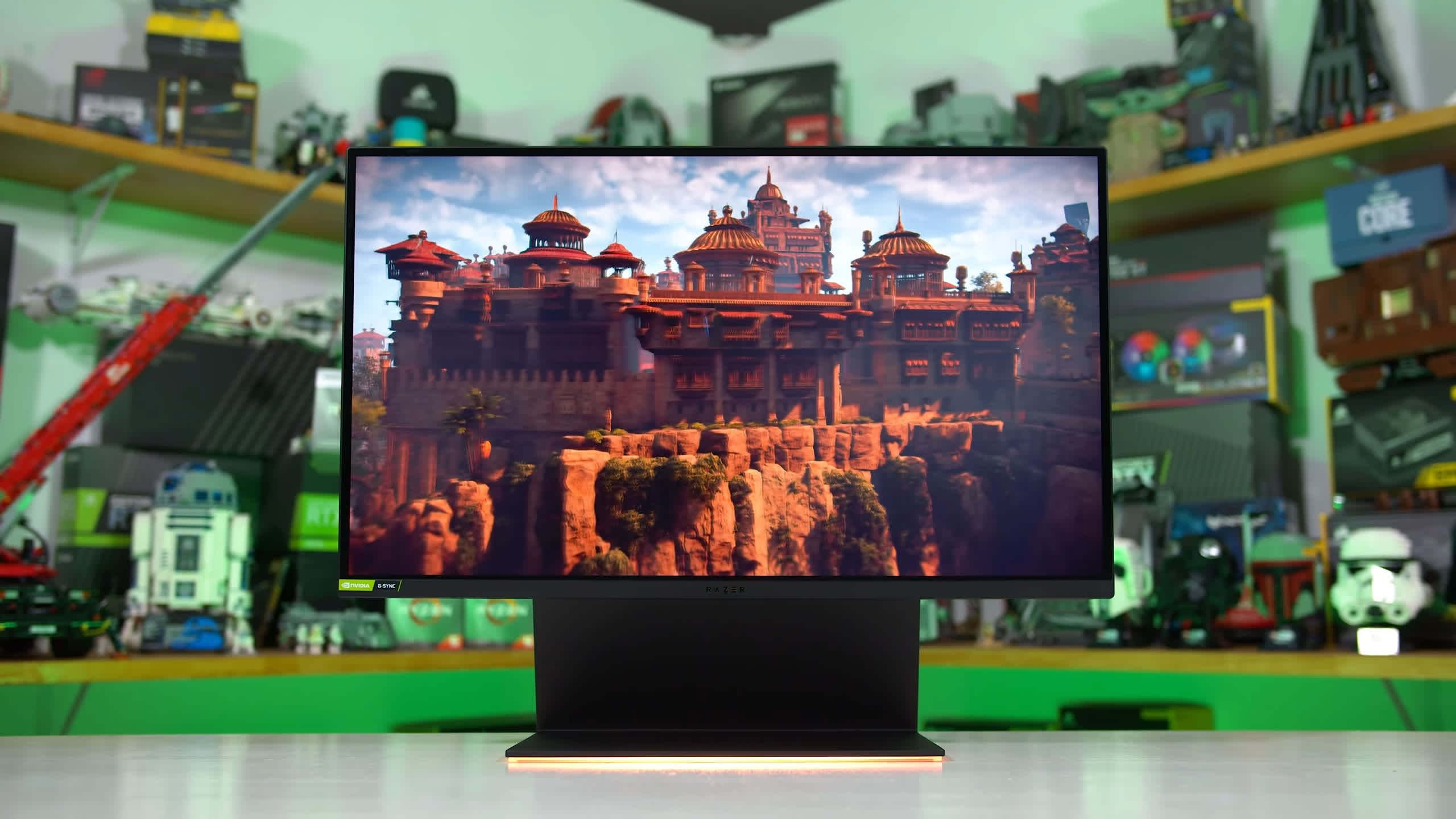
So what is the Razer Raptor 27? Well, for starters it's a monitor with a simple production proper name, and so at least that'due south a positive. Well, possibly not a complete positive as at that place's a new version and an old version.
The 1 we're testing today with a 165Hz refresh rate was released in 2022, while the older Raptor 27 from 2022 sports a 144 Hz refresh charge per unit -- nosotros never reviewed that one. I really hate it when companies release new versions of products that are called the exact aforementioned thing as the quondam one, but that'due south the least of the concerns with this monitor.
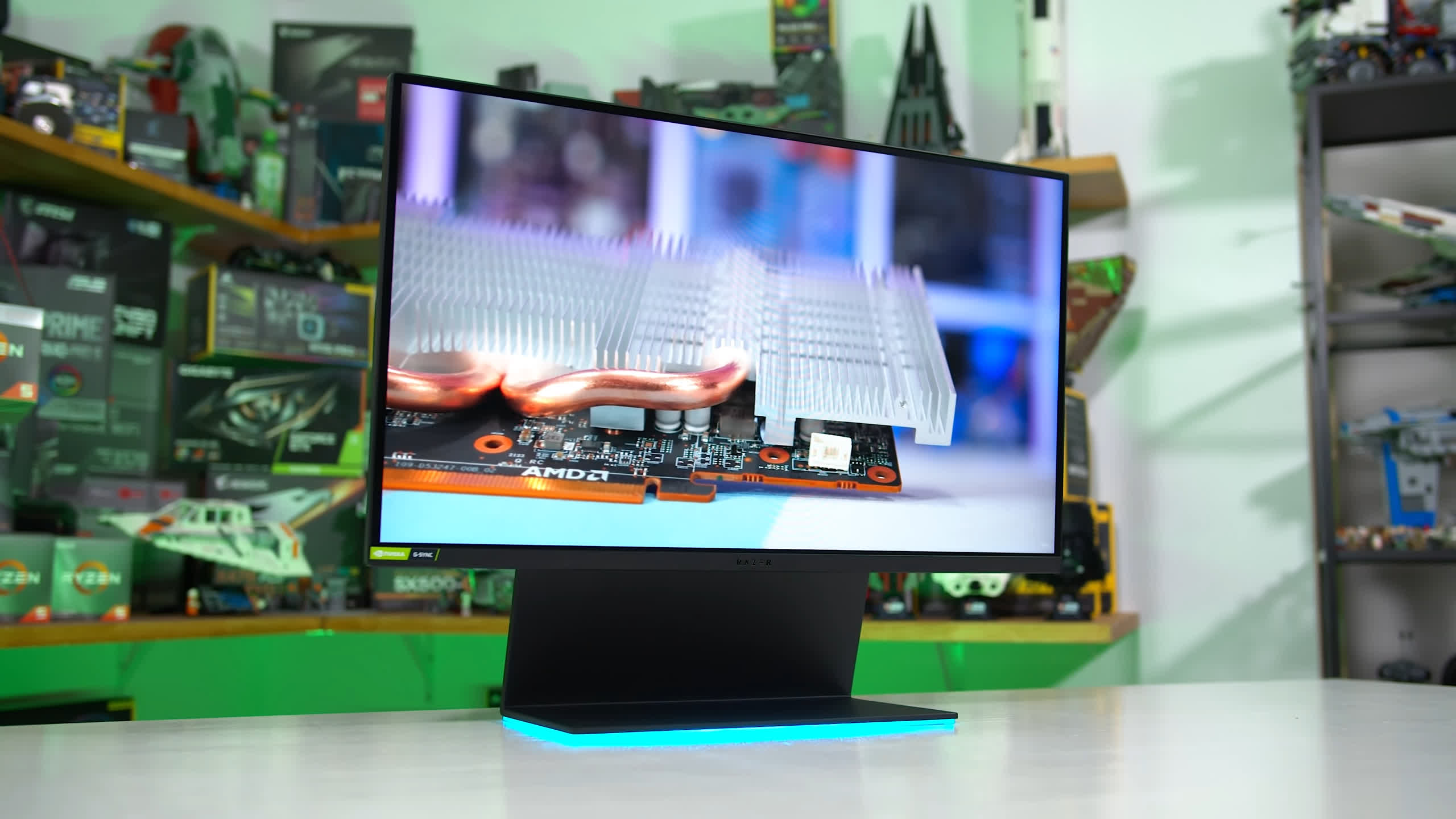
The Raptor 27 is a 27-inch 1440p 165Hz IPS gaming monitor, the kind of specs that are mostly attractive to gamers. We're getting adaptive sync back up through Nvidia G-Sync Compatible and AMD FreeSync Premium, and it's even been THX Certified, supposedly "to ensure that the paradigm displayed is as truthful to the source as possible."
Razer are challenge this is the world'southward beginning monitor to receive that certification. 95% DCI-P3 coverage and "HDR 400" are also included.
Design and Form Cistron
1 of the more heed-boggling aspects to the Raptor 27 is the cost tag of $800 (or ~$710 at Amazon). For some reason Razer thinks they tin can justify selling a 1440p 165Hz monitor in 2022 for $800, the sort of price tag unremarkably occupied by 240Hz displays or 4K high refresh monitors. The Raptor would accept to be exceptional to justify that sort of toll tag, which I think if you lot've seen the title of this review, you know how this is going to play out.
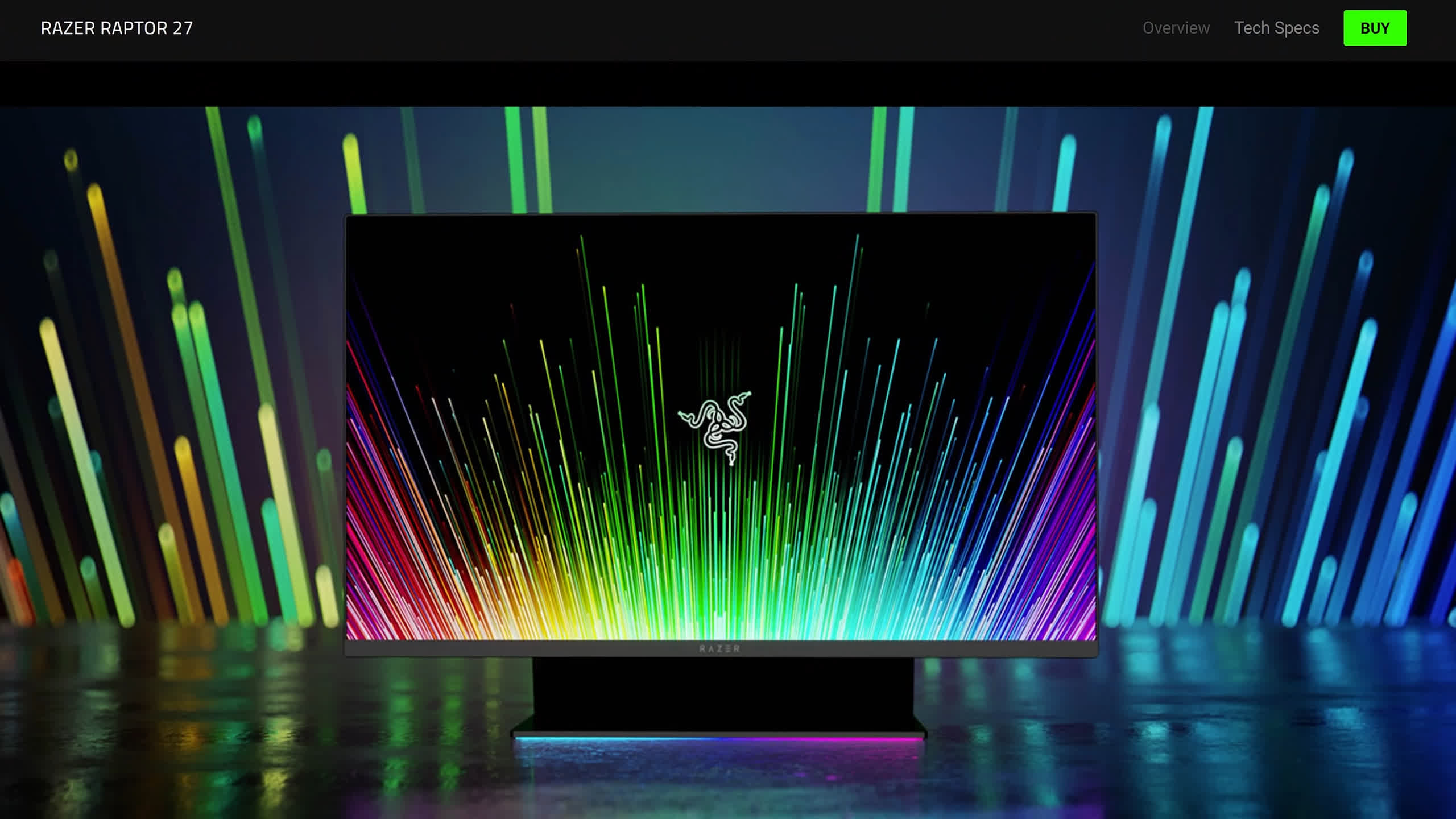
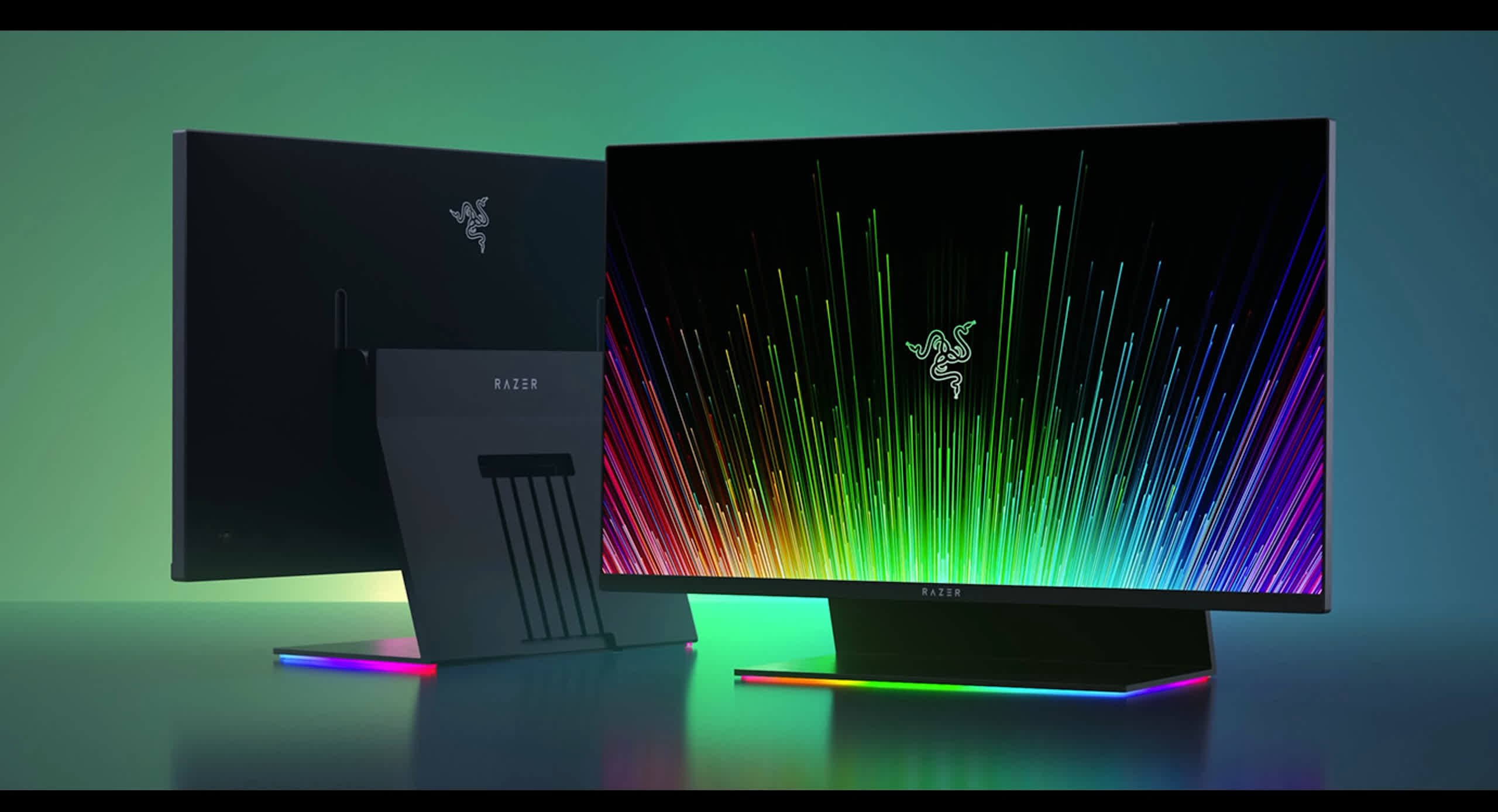
The commencement red flag when analyzing the Raptor 27 is right at the height of the production page with the start hero shot of the display. Beautiful large screen with very slim bezels extending nearly edge to edge, scroll down a little bit more and the same sort of thing, super slim bezels.
The reality? This is what the Raptor 27 actually looks like (beneath), and information technology has regular bezels, not the super slim ones seen on Razer's website. In my opinion, this constitutes false advertising, if you're buying the Raptor specifically because it has slim bezels then there is no uncertainty you'll be disappointed when the concluding product arrives.
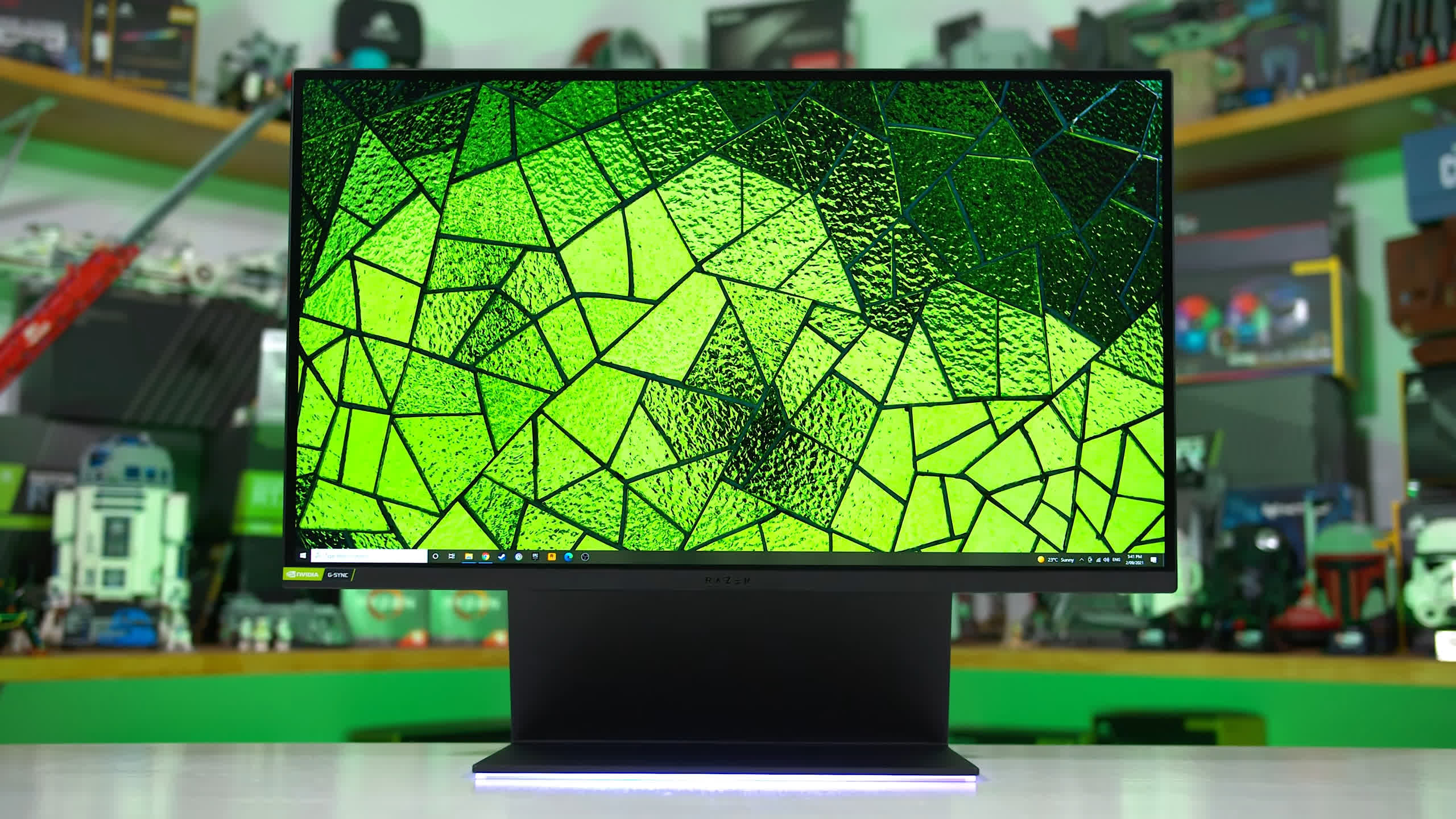
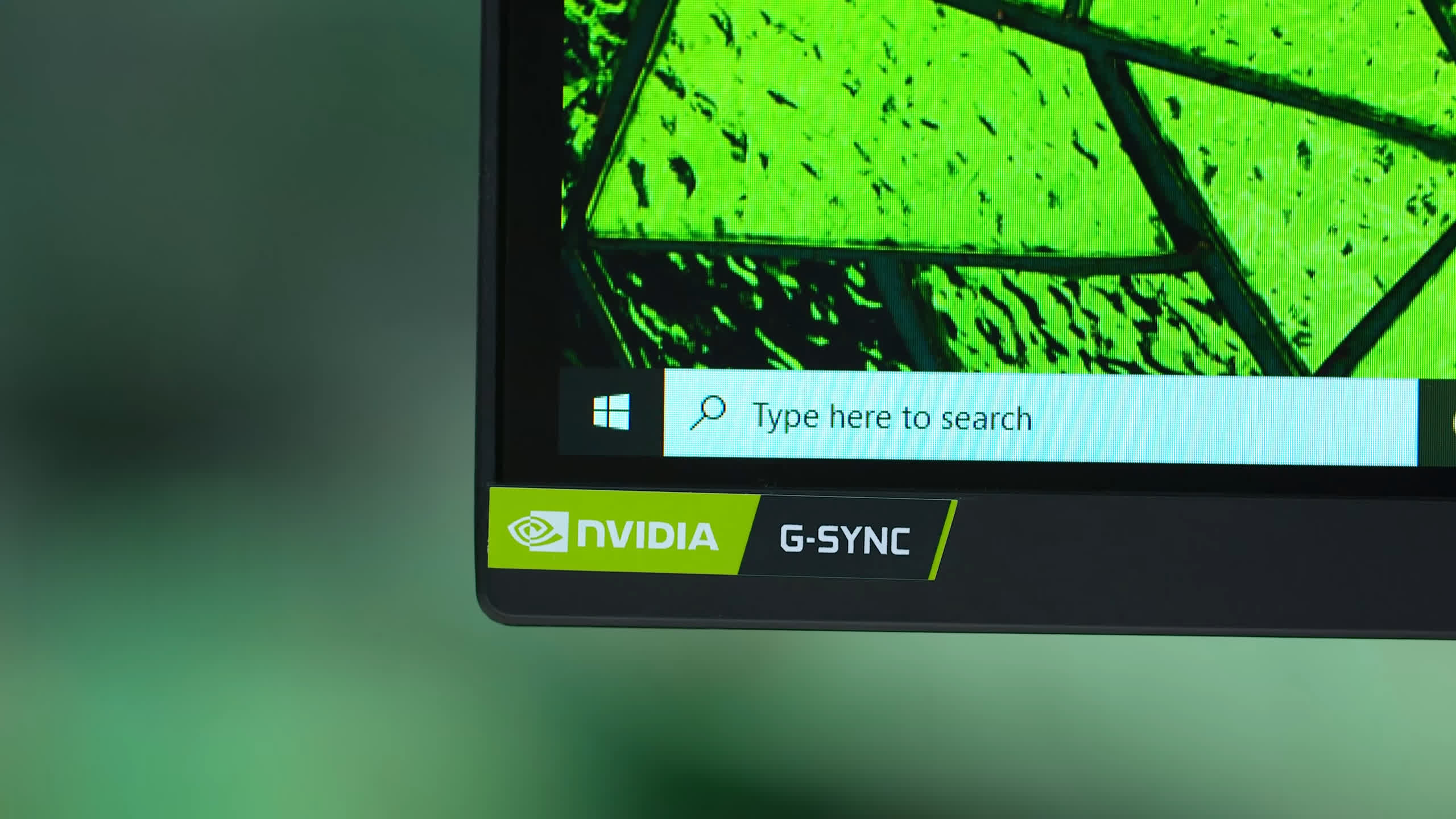
And that's a shame because this is not required to sell the Raptor 27 on its design. One of the positives near this monitor is the overall design and build quality. Information technology'due south not frequently that I tin describe a monitor as having a "unique" design, but that perfectly applies in this case.
Nosotros're getting this wide metal stand with an RGB LED calorie-free bar around the base, a unique cable direction system that runs down the dorsum of the stand using a bunch of Razer'southward included acrid green cables, and a rear panel with a material cease rather than the usual plastic.
It's a keen looking monitor that could hands be a statement piece to complete your gaming setup.
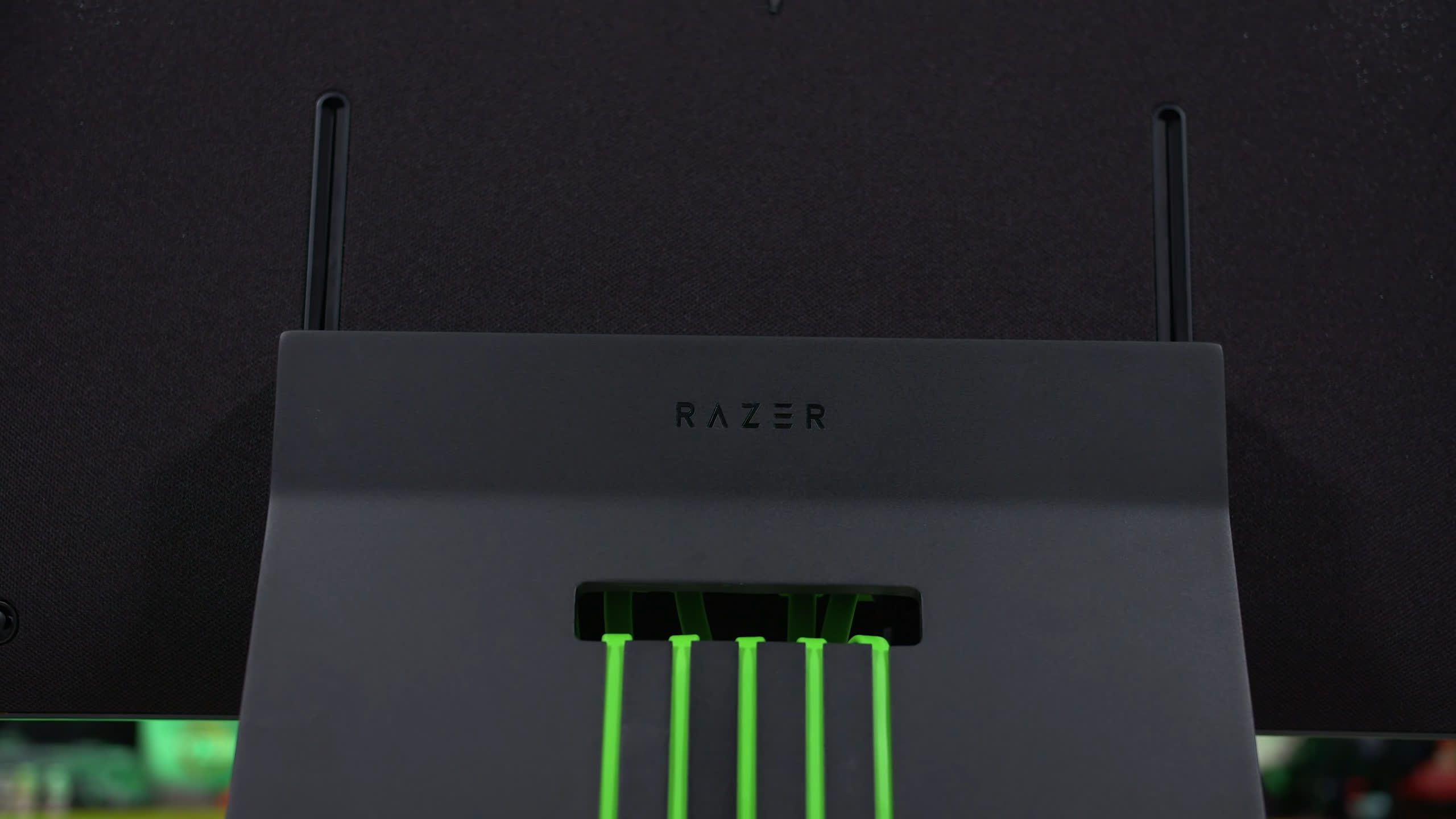
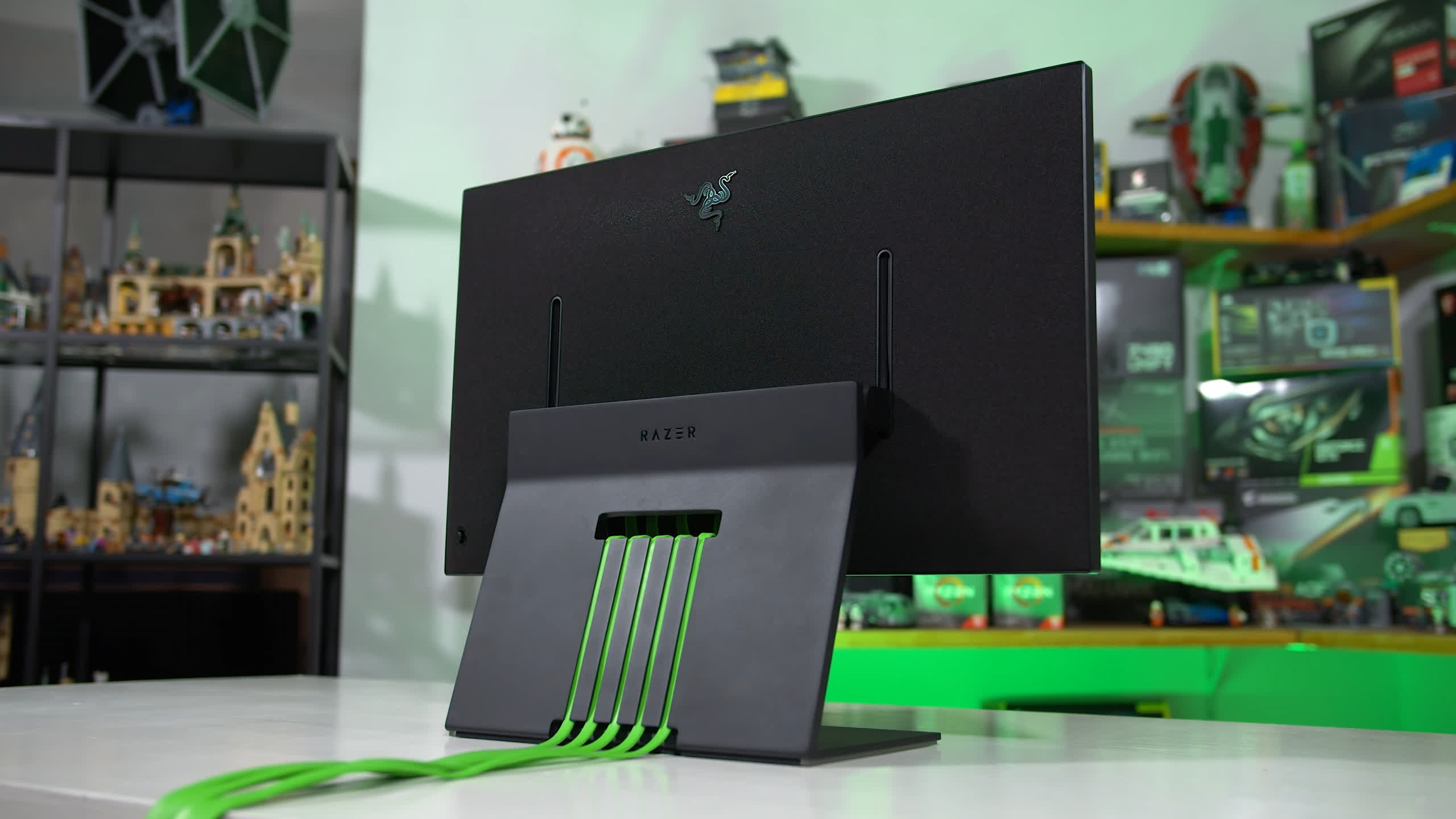
In fact I'd far prefer this sort of gaming monitor blueprint than what companies similar Asus and Gigabyte ringlet out for their ROG and Aorus products respectively. Information technology's uncomplicated, it uses loftier quality materials, it has some really neat highlights of color, and the low-cal bar around the base I think is one of the more impressive RGB inclusions on a monitor – nigh of the time it's useless, only I retrieve this design works.
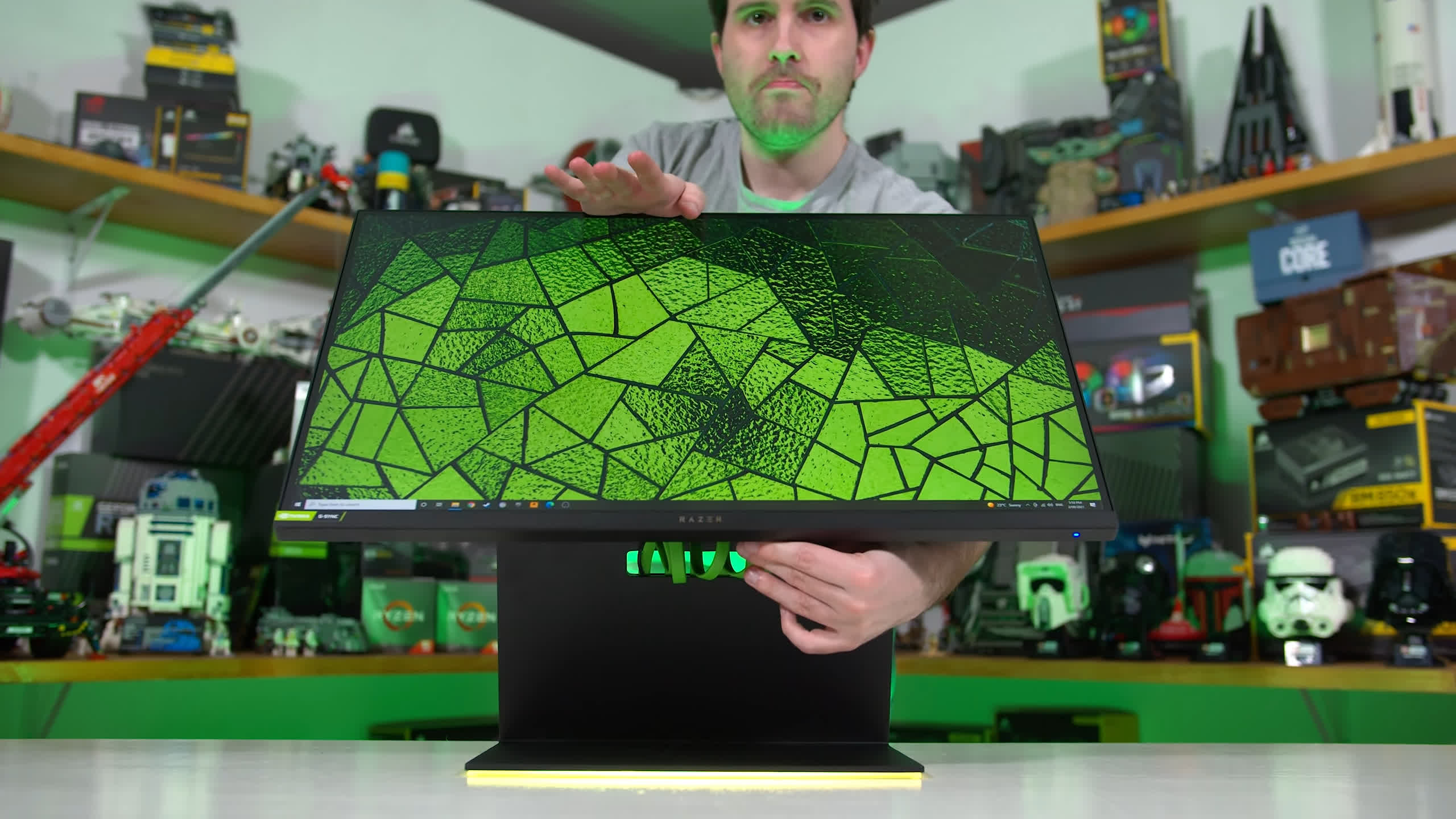
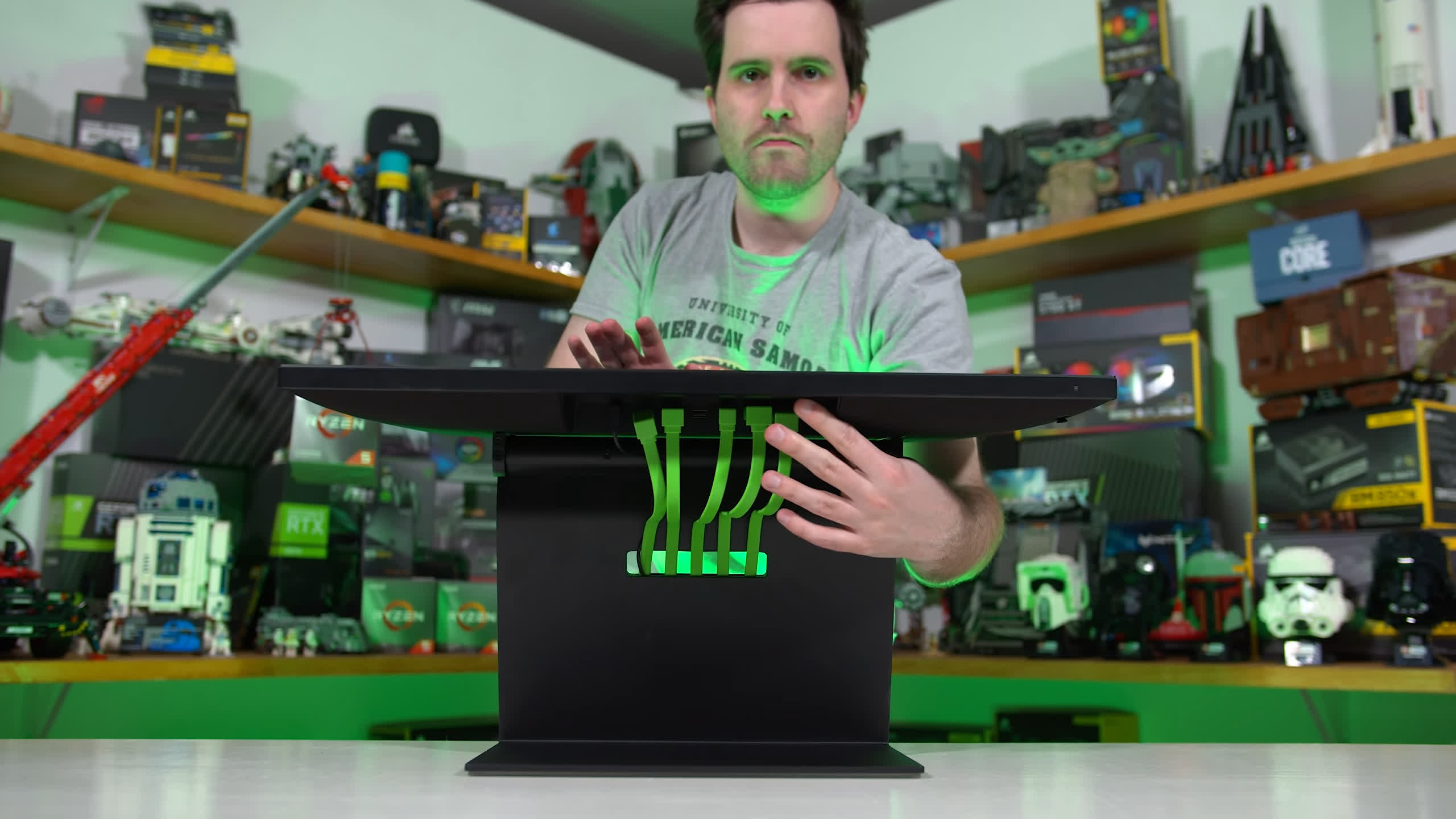
Much to my surprise, the monitor is still acme adjustable, the stand up connects to two sliding mechanisms on the rear and that gives some range of motion. The maximum height is yet too low down for my liking, just it's amend than nothing.
The monitor also has an insane tilt range, including the power to tilt horizontally flat to give easier access to the ports for cablevision management. That'southward another unique design element I oasis't seen before. Unfortunately though, tilt and swivel back up take been sacrificed, and VESA mounting is not included out of the box – you'll need to purchase a separate adapter which is a chip crazy when the display costs $800.
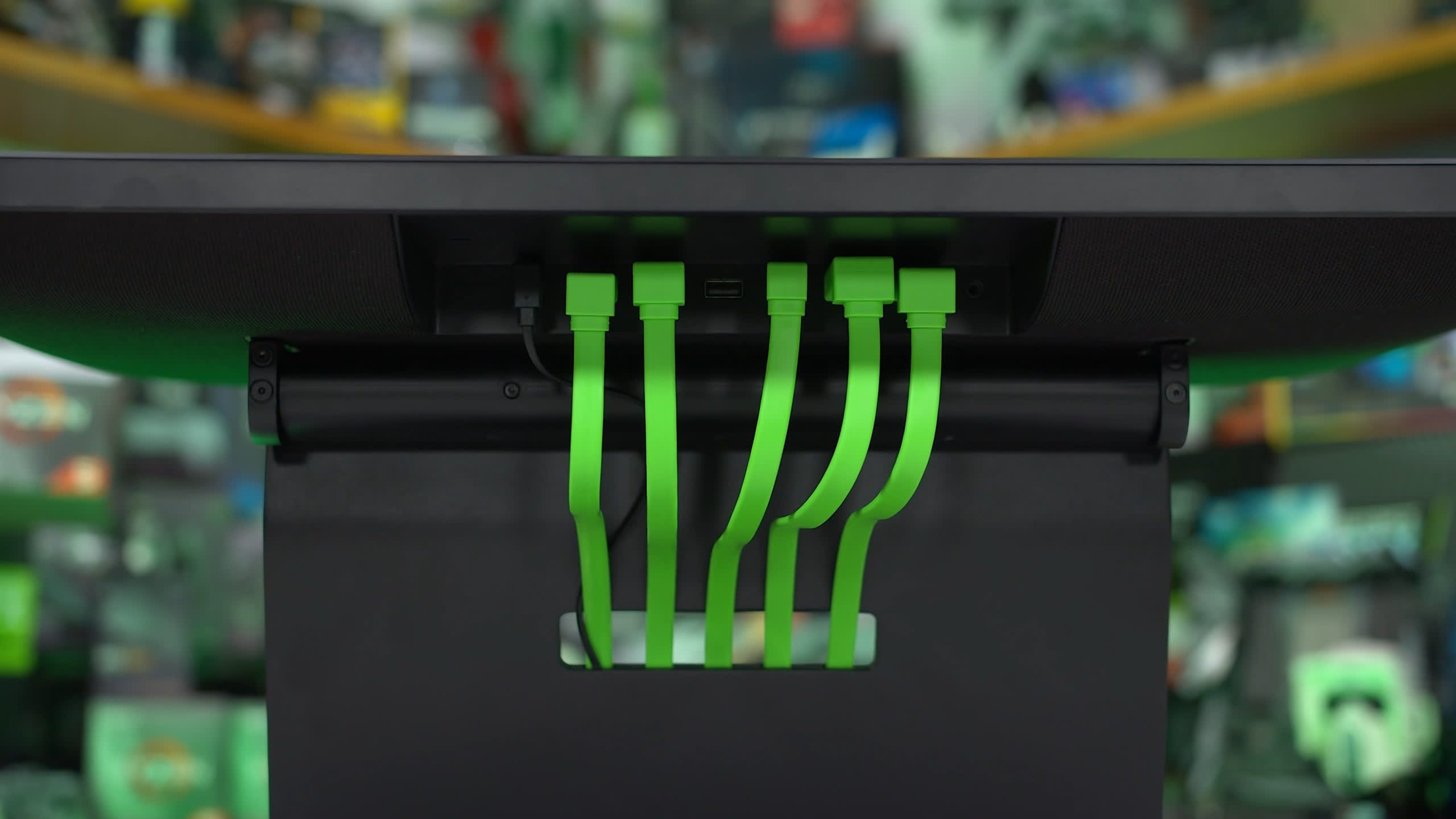

Included ports are HDMI 2.0b, DisplayPort 1.four and USB-C that supports DP Alt Mode. There's also a couple of USB ports you can use as a hub. Equally for the OSD, directional toggle on the rear and the navigation organisation Razer are using is quite good, fast and piece of cake to utilise. However the feature fix is lacking, if you do want stuff similar cheat crosshairs or low blueish light modes, you won't find that here, most of the controls are limited to bones functionality like color controls and overdrive settings.
Display Performance
Response time performance is up next, and this is where the Raptor 27 fails. I'thou a little surprised Razer sent out this monitor to be put through this testing, information technology's a bit like sending something straight to the firing squad, but they did, so we'll examination information technology.


First upwards, overdrive off performance. Non a nifty outset with slow response times, just it'due south overdrive off, so we can't read likewise much into it. Simply side by side upwards we have Weak overdrive and… well this isn't much of an improvement. Cumulative difference has decreased which is a good thing, but response times have merely improved by ane.5ms and so it'due south not exactly a big alter. There are noticeable ghosting trails following moving objects using this mode and refresh rate compliance of 0% is obviously terrible.

The next fashion is Strong, which is an improvement in many areas. Boilerplate response fourth dimension has improved to 8.33ms and cumulative difference is now a lot better likewise, all with goose egg overshoot at the maximum refresh rate. However as yous can come across performance is a bit weird, with some responses being reasonably quick, and others tailing off a bit at the terminate, in particular these darker transitions in this surface area. I've tripled checked these results including looking at the raw response curves and basically some transitions are well tuned but others are non. This isn't that uncommon for some console types, but information technology'southward also not ideal as there can even so exist mistiness trails introduced past these slower transitions.



Overall this performance simply isn't that expert either. Refresh rate compliance of 59% isn't what we've come to wait from modern high end IPS panels at 165Hz. But it gets worse at lower refresh rates. When dropping downwardly to 120Hz we start to encounter noticeable inverse ghosting, then at 100 Hz these trails become very obvious using the Strong mode. Not but do we run into an inverse ghosting rate of 52% hither, but sometimes the corporeality of overshoot is in the range of 30% which is very noticeable. Cumulative deviation suffers as a result, even though response times are okay. Then when we get downwardly to 60Hz this overdrive setting is practically unusable as the level of overshoot is far too loftier and leads to potent inverse ghost trails.





The other option for adaptive sync gaming is using the Weak mode, merely this mode is far too wearisome for gaming at the upper refresh range. Information technology is ameliorate at 100Hz and lower where there is no overshoot so yous don't become inverse ghost trails, but these trails are simply replaced by blurry ghosting trails as the response times themselves are as well tedious.
And then we've found the first issue with the Raptor's response performance, and that'south the lack of a single overdrive fashion experience. This isn't fifty-fifty a "non quite in that location" moment, this is a full blown it cannot deliver good performance across the entire refresh range with a single mode. Weak is far likewise ho-hum at 165Hz but has no overshoot at lower refresh rates, while Strong has far too much overshoot at lower refresh rates but better performance at 165Hz. Y'all'll need to constantly moving-picture show back and forth between these settings depending on the refresh rates you recollect you'll exist gaming at, to avert unsightly artefacts on either end of the scale.
This is not practiced enough for an $800 monitor. This is a high end product priced well above the competition, and so I expect to get a single overdrive mode experience. If the Raptor 27's console tin can't practise it natively, Razer should have implemented variable overdrive, whether through their own method or through a full G-Sync module. To go this variable refresh rate experience at this price is pretty disgraceful given I could listing off about x monitors in 20 seconds that can practice a better job.

Only information technology gets worse when comparing the Raptor to other monitors, as not only is the variable refresh rate feel bad, it'south also a slow monitor relative to others fifty-fifty in the best conditions. Information technology performs similarly to the Pixio PX277 Prime number and Gigabyte M27Q which are both around the $350 mark – again the Raptor is an $800 product. The MSI MAG274QRF-QD is 34% faster at 165Hz and this only gets worse with products like the LG 27GP850 providing nearly 80% faster transition times. Ouch.

And this is illustrated really well when looking at UFO Tests using BlurBusters' utility. The Raptor 27 fifty-fifty in its best case scenario using strong overdrive has noticeable ghost trails behind the UFO, unlike the models from MSI and LG (which by the way are both substantially cheaper). This is how the numbers in the graph translate to real life visual effects: the MSI and LG monitors are faster in the charts and clearer in the exam.

To brand matters worse, at $800 you can easily buy 1440p 240Hz monitors like the Gigabyte FI27Q-Ten or Samsung Odyssey G7. This is what these faster monitors look similar, information technology's a massive difference in movement clarity provided not but by faster response times, but a higher refresh rate besides.

The Raptor 27's performance across the refresh range is quite poor and bluntly a bit embarrassing. I've chosen the Potent overdrive fashion to show here merely the Weak fashion is even worse on average. Basically you're not simply getting response performance 21% slower than LG's two-twelvemonth-onetime, $300 cheaper 27GL850, but the LG model also does so with less than a third of the amount of inverse ghosting.

This comes across well in the cumulative deviation numbers, which show the balance of overshoot and response times in a single number, while also telling us how shut a monitor gets to the ideal instant response time. The Razer Raptor 27 is astonishingly bad for an $800 production in this metric, simply matching the entry-level Pixio PX277 Prime and getting slaughtered past most modern IPS gaming monitors including the $330 Gigabyte M27Q and basically everything else. A adept score for an IPS is effectually 520, 65% better than what the Raptor 27 is providing.
This leads me to conclude that the Raptor 27 is either using a final generation panel or an entry-level panel, or perhaps even both. This sort of operation was the norm back in 2022 to 2022 (at a lower price bespeak mind you) but it simply does not cut it in 2022.


At a fixed 120Hz refresh rate, the Raptor performs poorly, with a boring response time and lots of overshoot. It'due south no better at 60Hz, where ideally you should turn the overdrive setting downwardly to Weak to get the all-time operation. Here the Razer monitor is even slower than Gigabyte'southward entry level and bully value M27Q which is ridiculous for a high-terminate product.

Input latency is fine given the processing delay on the monitor's side is under 1ms. However slow response times contribute to a slower full input latency value, every bit information technology takes longer for the monitor to reach its final output than others on the marketplace. Again, at this price point, you lot tin can purchase 240Hz 1440p monitors like PG279QM which deliver far superior input latency due to their higher refresh charge per unit, which is largely the limiting gene with modern displays.

Power consumption is good. Even with the RGB LED low-cal bar enabled, the Raptor 27 consumes a similar amount of power to other monitors with 27-inch screen sizes and similar specifications. And so thankfully this is a not result.

The Raptor 27 does support backlight strobing, although it cannot be enabled simultaneously with adaptive sync. This feature is poor with significant strobe crosstalk and no settings to control strobe length or timing. While motility clarity is somewhat improved compared to non using the mode, ultimately you volition run across lots of double or triple images in motion, which is not great. Simply put, the panel is too slow to properly support backlight strobing at this sort of refresh rate.
So at this indicate we know that the Raptor 27 has very poor motion performance for an $800 monitor, performing more like entry-level $300 monitors, and information technology lacks the features that should be present with high end displays. And then surely to justify this price point, Razer take paid a lot of attending to color performance right? I mean it's THX Certified? Doesn't that mean information technology'south good? Wrong. Information technology's not.
Color Performance
Color Space: Razer Raptor 27 - D65-P3

To offset off the color space is fine. 95% DCI-P3 is listed on the box and 95% DCI-P3 is what we get. This gives us pretty close to full coverage of two color spaces: sRGB/Rec. 709, and P3. Yet it doesn't meaningfully back up Adobe RGB, which some of the best high-end IPS monitors of today can practice, even in gaming displays like the MSI MAG274QRF-QD. Equally nosotros look at Rec. 2022 coverage the Raptor 27 comes in at 70% which is fine, just it's those 80%+ monitors that are the best for content creation as they give 100% Adobe RGB support. So in that sense the Raptor 27 is still not quite performing as I'd like to come across from a flagship, super expensive product.
Default Color Performance



Despite the spec sheet saying the monitor is manufacturing plant calibrated, bodily results say that factory calibration is mediocre. Greyscale results are short of what is required for a gaming monitor. The white point is incorrect and my unit was tinted slightly ruddy out of the box, and while gamma adherence is okay, this simply leads to boilerplate deltaE results for greyscale, not what I'd call perfect. It's also oversaturated by default, as the monitor's wide gamut is unclamped, despite the vast majority of SDR content today calling for an sRGB or Rec. 709 colour infinite.


At present when I saw the spec sheet and all the claims about scale and accurateness, I thought… so is there some other mode that's manufacturing plant calibrated? Out of the box the monitor is more accurate for D65-P3 but not actually accurate, certainly non "factory calibrated" level accurate.


And so there's the Rec. 709 mode which is included in the OSD. Is that authentic to Rec. 709? Not really, Razer has failed to calibrate the gamma to BT. 1886 and while the color space is clamped to a more than appropriate degree, sure colors like red remain oversaturated in the mid-colour range.



What about the DCI-P3 mode? This way is the most accurate and Razer have at least tried to get the right two.6 gamma, but the white point is nonetheless incorrect, for DCI-P3 it should be green-tinted 6300K. This means anyone wanting to use this monitor for editing videos in the DCI-P3 color space will still accept to calibrate it themselves.


There's also a few THX modes included just they seem to be a variation of the Rec. 709 mode, and all of these modes except for default limit things like gamma and white betoken controls, which as we've said many times is unnecessary and prevents fine tuning. Some even restrict brightness. At that place'due south really no good sRGB manner or even Rec. 709 mode every bit a result.
How does this happen? How does a monitor get from "factory calibrated" and THX Certified with "rigorous testing procedures" to "ensure that the image displayed is as true to the source as possible" … to not actually being that well calibrated at all? Isn't an external body certifying this monitor?
Well I don't know for certain how the THX Certification process works, so I can't comment on whether the monitor really meets their standards or non. But my speculative judge here is that Razer submitted one platonic sample to THX for certification, and it passed with good calibration. All the same, what is a reasonably common practice is that manufacturing plant calibration is only performed on one monitor sample, then applied to all production models. This process won't actually lead to properly calibrated results on every display, as there are e'er variances betwixt panels, even so companies tin claim that "factory calibration" has been done without calibrating each individual unit.
This sort of practice is misleading and the sort of weasel words I hate in marketing. Now again I don't know for sure that this is the reason why we're seeing the results we're seeing, it's just my best approximate. What's clear though is that Razer are either not individually factory calibrating each monitor, which would be a much more time consuming and expensive process, or they are individually calibrating but doing it wrong. Really for $800 they should be properly individually calibrating every display, simply based on my testing they aren't.
And I just want to be clear that this isn't some magical mythical performance benchmark that no monitor has ever reached. I've tested several high cease monitors that do actually come factory calibrated, or at to the lowest degree factory calibrated to a very proficient extent. The Raptor 27 is not one of those displays.
Calibrated Color Performance





This isn't the end of the world though, as the Raptor can be calibrated to deliver excellent results. The panel is easily capable of full sRGB coverage, so a calibration laissez passer using Calman will deliver essentially perfect reproduction of sRGB or Rec. 709. 95% DCI-P3 coverage is also good plenty that if you do calibrate to P3, you'll get a largely accurate experience that is suitable for piece of work in this color space. It's good monitor for productivity it merely isn't factory calibrated to the level the Razer website would suggest.

The Raptor 27's peak SDR brightness is acceptable at 363 nits, though this falls short of the 380 nits Razer advertises. The only fashion to increase brightness across this figure is to run the monitor in the HDR mode, which can do approximately 450 nits. This will artificially make the HDR mode look brighter and subjectively "ameliorate" despite this display not including proper HDR hardware similar local dimming. Minimum brightness is pretty good, at 40 nits.

Contrast ratio is okay for an IPS panel at a lilliputian above 1000:1, although it'due south still an IPS-level contrast ratio, so information technology's quite a lot worse than today's VA panels like the Samsung Odyssey G7, and that ways night levels aren't great. Still, as Razer don't appear to be using an LG panel, you don't have to worry well-nigh a sub-m:1 contrast ratio similar with the 27GP850.


Viewing angles are very skillful for an IPS panel, as is text clarity. Uniformity was to a higher place boilerplate as well for the most part, my unit had express IPS glow and no noticeable backlight bleed, and only a minor portion of the display was slightly less uniform than the rest (the bottom left corner). For content cosmos though these uniformity results are adequate.
What But Happened?
Hopefully after seeing all these exam results you lot now take a clear understanding of why nosotros tin't recommend the Razer Raptor 27, and why I believe this display is an outrageous rip-off for customers. The Raptor 27 performs similar a $300 entry-level monitor in several areas, despite Razer setting the price tag at an center-watering $700+. There's admittedly no fashion I would ever consider paying $800 for this level of operation and information technology's puzzling to see Razer request for information technology in the starting time identify, too.
Response time performance is in the ballpark of monitors such as the Pixio PX277 Prime, and it's beaten at times by the $330 Gigabyte M27Q released last twelvemonth. LG'due south pop 27GL850 from 2022 is not only noticeably faster, it was also cheaper when it was released 2 years agone for $500.
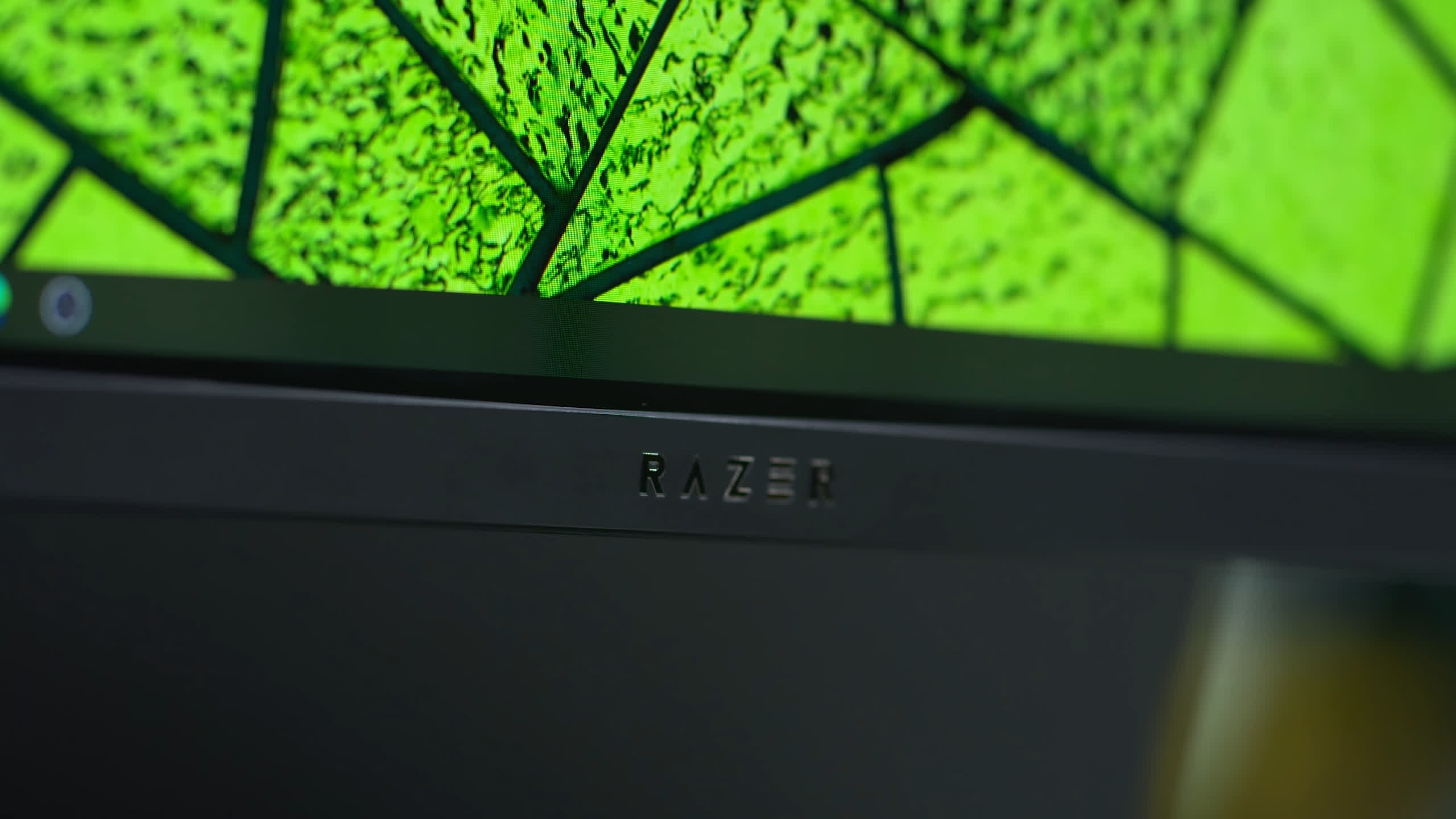
So, Razer is selling you lot a monitor that'due south slower than something released years ago, at a higher cost. On pinnacle of that, they haven't bothered to integrate high-stop monitor features similar variable overdrive to fifty-fifty partially brand up for the slow functioning by today'south standards.
And so for colour performance, this monitor is nothing special. It'southward broad gamut only not as wide every bit the all-time panels of today, brightness and contrast are average, and despite beingness advertised as mill calibrated and THX Certified, actual out of the box calibration is mediocre.
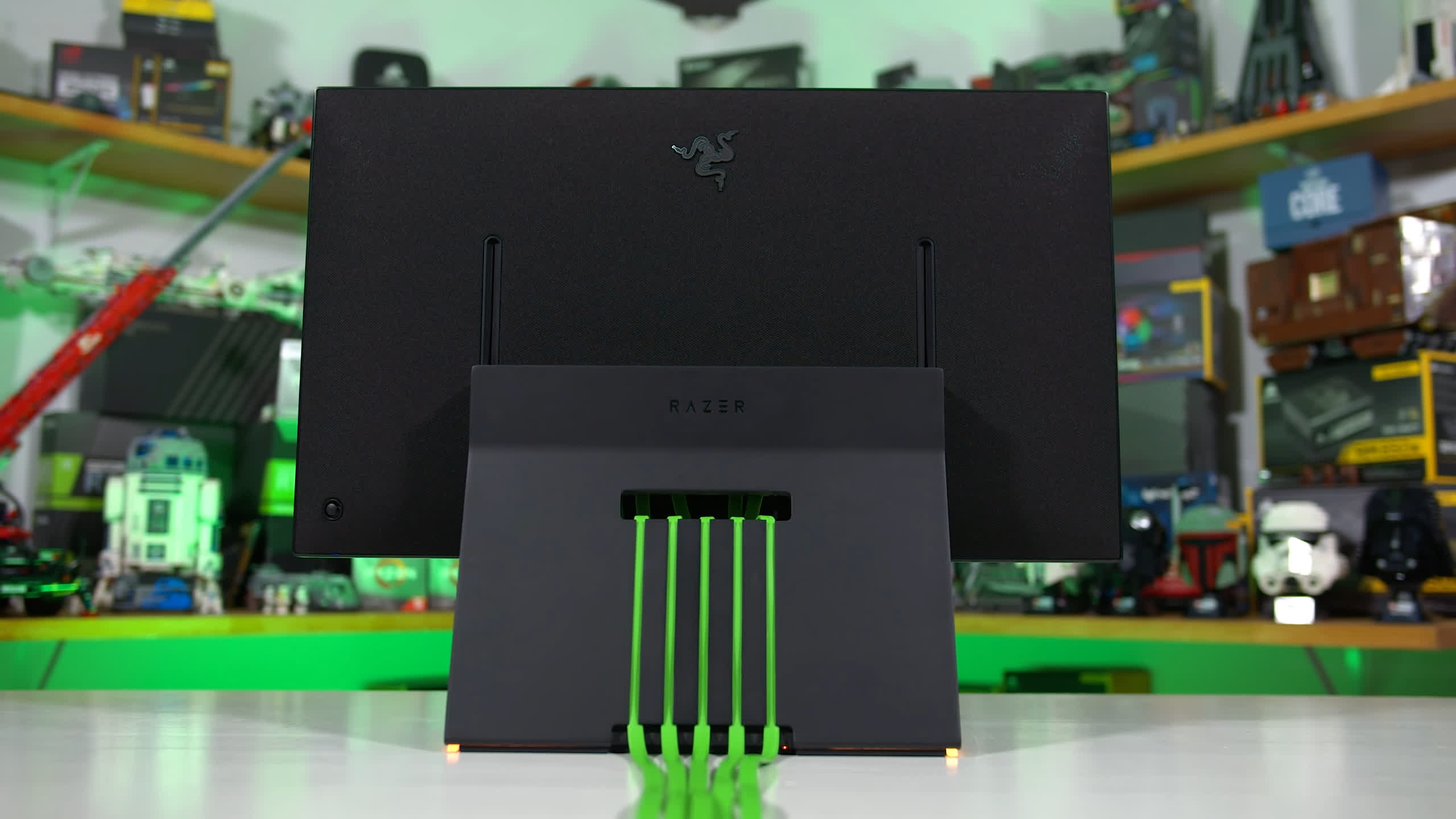
The only positive about this brandish is the cracking, unique design that looks excellent as role of a PC gaming setup.
Conversely, what is heed-blowingly hard to explicate, is that if a manufacturer wants to brand a loftier-cease 1440p 165Hz gaming monitor in 2022, there are genuinely dandy panels to cull from. My choice would exist the AU Optronics panel used in the MSI MAG274QRF-QD: it provides slap-up response times, would significantly amend backlight strobing, and has a much wider colour gamut.
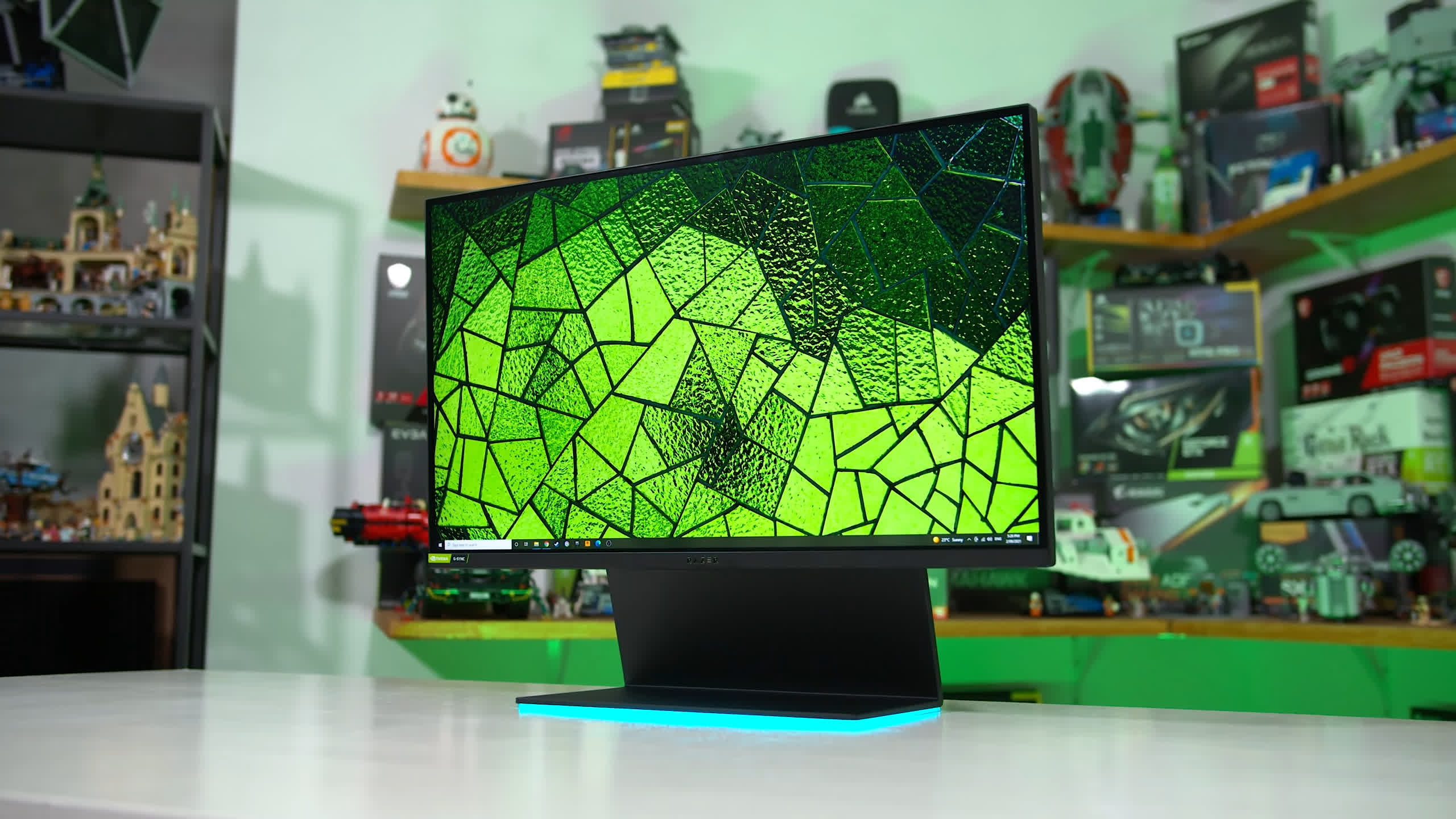
Why Razer didn't cull to use a more than modernistic panel in this refresh is beyond me, and shows it's no more than than a lazy update with performance stuck in the past. This sort of product genuinely makes me aroused because it's taking advantage of customers that don't exercise research and volition only look at the shiny marketing folio and Razer logo.
You lot literally can purchase better products for one-half the price. That MAG274QRF-QD I was only talking about? A $420 display. The Raptor 27 is $700-$800. Insane.
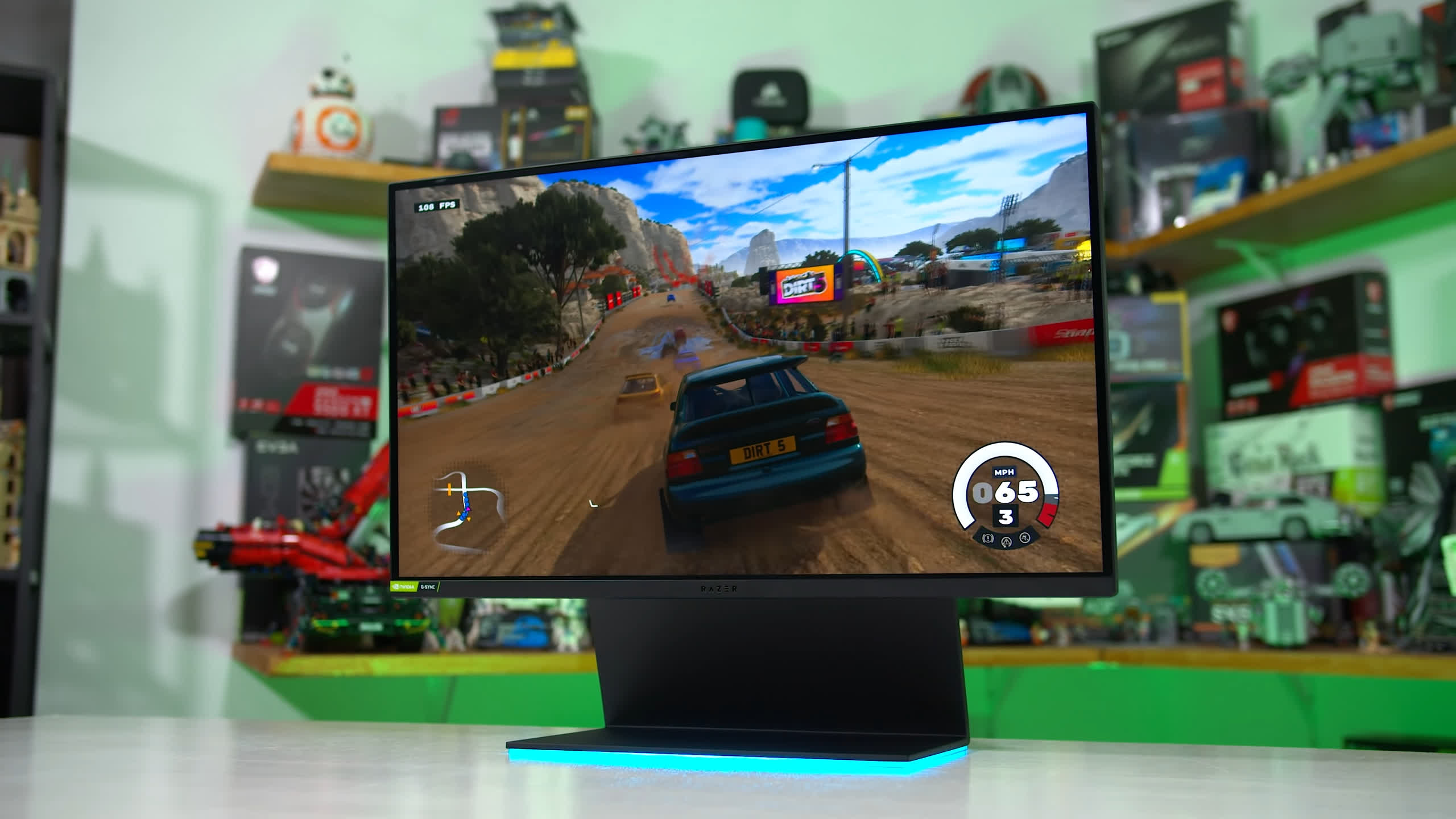
If you exercise have $800 to spend on a monitor, you lot tin get something far superior. Almost 1440p 240Hz monitors these days are effectually that toll, whether we're talking Asus PG279QM or Samsung Odyssey G7 or several others. Not only exercise these have higher refresh rates, they're likewise faster in general and typically have stronger feature sets. Alternatively, you could buy a 4K 144Hz display similar the Gigabyte M28U which is really $200 cheaper and overall a better product.
How tin can Razer salvage the Raptor and make it worth buying? That'southward a tall enquire, every bit substantially they'd accept to drib the price down to $400, which I can't imagine they are willing to do. But even at $400 I'd struggle to recommend it, so information technology'd more than likely have to be $300. They may every bit well just discontinue the production and try again.
Merely there's somewhat adept news, because Razer could make an $800 gaming monitor that'southward worth buying if they wanted to. If this was using a new 1440p 240 Hz panel, if information technology included variable overdrive, and if it was meliorate factory calibrated, it would be a good purchase. That'south a lot of ifs, just that'south the level nosotros are at today with gaming monitors, not what Razer is offer with the Raptor.
Shopping Shortcuts:
- Razer Raptor 27 on Razer, Amazon
- Asus ROG PG279QM on Amazon
- Gigabyte M27Q on Amazon
- Samsung Odyssey G7 32" on Amazon
- HP Omen Ten 27 on HP Shop
- Gigabyte Aorus FI27Q-Ten on Amazon
Source: https://www.techspot.com/review/2318-razer-raptor-27/
Posted by: floydandised.blogspot.com


0 Response to "Razer Raptor 27 Gaming Monitor Review"
Post a Comment